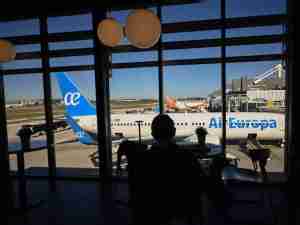Short on time and running out of options after its scuttled merger with JetBlue Airways Corp., Spirit Airlines Inc. is left looking to debtholders for a lifeline. They will want a lot in return.
Lenders whose bonds hemorrhaged value as the deal failed are getting creative to plot a rescue of the airline — and their investment in it. The mission involves navigating two novel features of Spirit’s debt in order to protect themselves along the road to recovery.
First, a proposal under consideration by the lender group involves asserting a “triple-dip” legal claim that market observers say has never been seen before in corporate debt negotiations, according to people with knowledge of the discussions. Meanwhile, resulting debt talks could also present the first-ever restructuring of debt backed by loyalty programs, a pandemic-era practice among cash-strapped airlines.
The nascent plans come as the struggling airline needs to shore up its coffers. In the 20 months since JetBlue’s now-dead $3.8 billion offer, Spirit has continuously burned cash and lost profit margin. Wall Street analysts have speculated that it could be forced into bankruptcy reorganization or even liquidation. Spirit says it has sufficient liquidity to stand on its own.
A representative for Spirit declined to comment on the prospect of restructuring and said the company “is confident in its strengths and is focused on returning to profitability,” including through “assessing options to refinance upcoming debt maturities.” Representatives for the bondholders declined to comment on their plans.
Loyalty Lending
Of prime concern for debtholders is that Spirit’s frequent-flyer program — a bundle of customer data, subscriptions and branded credit cards — loses value dramatically with the airline’s survival in doubt. The program was valued around $2.6 billion in an independent appraisal in 2022, according to corporate filings.
“If Spirit’s underlying business transporting travelers is not in operation, the frequent-flyer program is worth very little, if anything,” said Reno Bianchi, president and chief executive officer of aviation debt research firm Asterisk Advisors.
While loyalty programs typically survive out-of-court mergers, their fate is less certain in bankruptcy, where deal terms tend to skew more to buyers’ whims. The Spirit programs — which include a ‘Saver$ Club’ and appeal to bargain travelers — are less attractive than the average airline’s, said Bianchi, who also spent over 30 years in aviation finance at firms including Cantor Fitzgerald, Seaport, Citigroup and Credit Suisse.
“The people who choose to fly with Spirit do so because it is the cheapest option; they are budget leisure travelers and will move to any airline that charges $10 less,” he said.
Triple Claim
The lenders’ potential legal approach, which is still in the planning stages and could change, involves emphasizing the control they wield over Spirit based on holding a trio of overlapping claims via quirks in the corporate structure. Advisers to the group, say the people, maintain the triple claim could give them the opportunity to recover their full investment in a potential bankruptcy, even if it meant seizing all of Spirit’s best assets.
Similarly, they say, it constitutes an effective ban on the airline raising new money from outside parties, since the group’s claims leave nothing left to mortgage.
Presenting their claims to Spirit could serve as an avenue to jump-start financing talks with a company that’s otherwise been reluctant to engage, said some of the people, who asked not to be named citing private plans.
The airline must at a minimum address the upcoming maturities of bonds held by the group, which are due in 2025 and 2026. Spirit’s current cash-burn rate suggests difficulty repaying those, and its outlook would present a challenge to refinancing. The company had $1.3 billion in liquidity at the end of 2023, and has been burning about $500 million yearly, according to company filings.
Desperate Times
The novelty and complexity of the bond group’s potential legal strategy speak to just how dire circumstances have become for both Spirit and its backers.
Spirit’s securities linked to the frequent-flyer program have plunged each time the deal with JetBlue lost support, shedding as much as 36% of their value within a single week when a US district judge blocked the merger on antitrust grounds.
They have since recovered some of those losses, and the 8% bonds due 2025 last changed hands at around 74.25 cents on the dollar, to yield nearly 30%, according to Trace.
The triple-dip claim under consideration is similar to a structure that’s been gaining popularity among holders of debt facing a near or total wipeout in a prospective bankruptcy.
The debtholders, usually in exchange for contributing more cash to a failing investment, receive extra layers of entitlement to assets through a “double-dip,” multiplying their chances to recover value if goods are liquidated.
One difference for Spirit lenders: all three claims are already attached to their debt, according to the argument advisers are mulling. Where past scenarios have seen debtholders offer new money in exchange for additional claims, the group’s strategy may constitute the reverse: using existing claims as leverage to guarantee they are the only ones to fund new loans.
Value Judgment
A bankruptcy for Spirit Airlines is far from certain. The company has cash on its books, and Chief Financial Officer Scott Haralson on its last earnings call referenced $1.2 billion worth of assets it could pledge to raise money.
A deal with lenders could keep Spirit operational long enough to vanquish cash burn and regain profitability. Alternatively, another takeover bidder could emerge. Ultimately, though, Spirit’s routes are now limited, said Christian Hoffmann, managing director and portfolio manager at Thornburg Investment Management Inc.
“This merger was blocked because of anticompetitive concerns and worries about consumer choice,” Hoffmann said. “Ironically, the outcome leaves Spirit Airlines with fewer options to fend off bankruptcy, and consumers with fewer healthy airlines to choose from.”
--With assistance from Aashna Shah.











